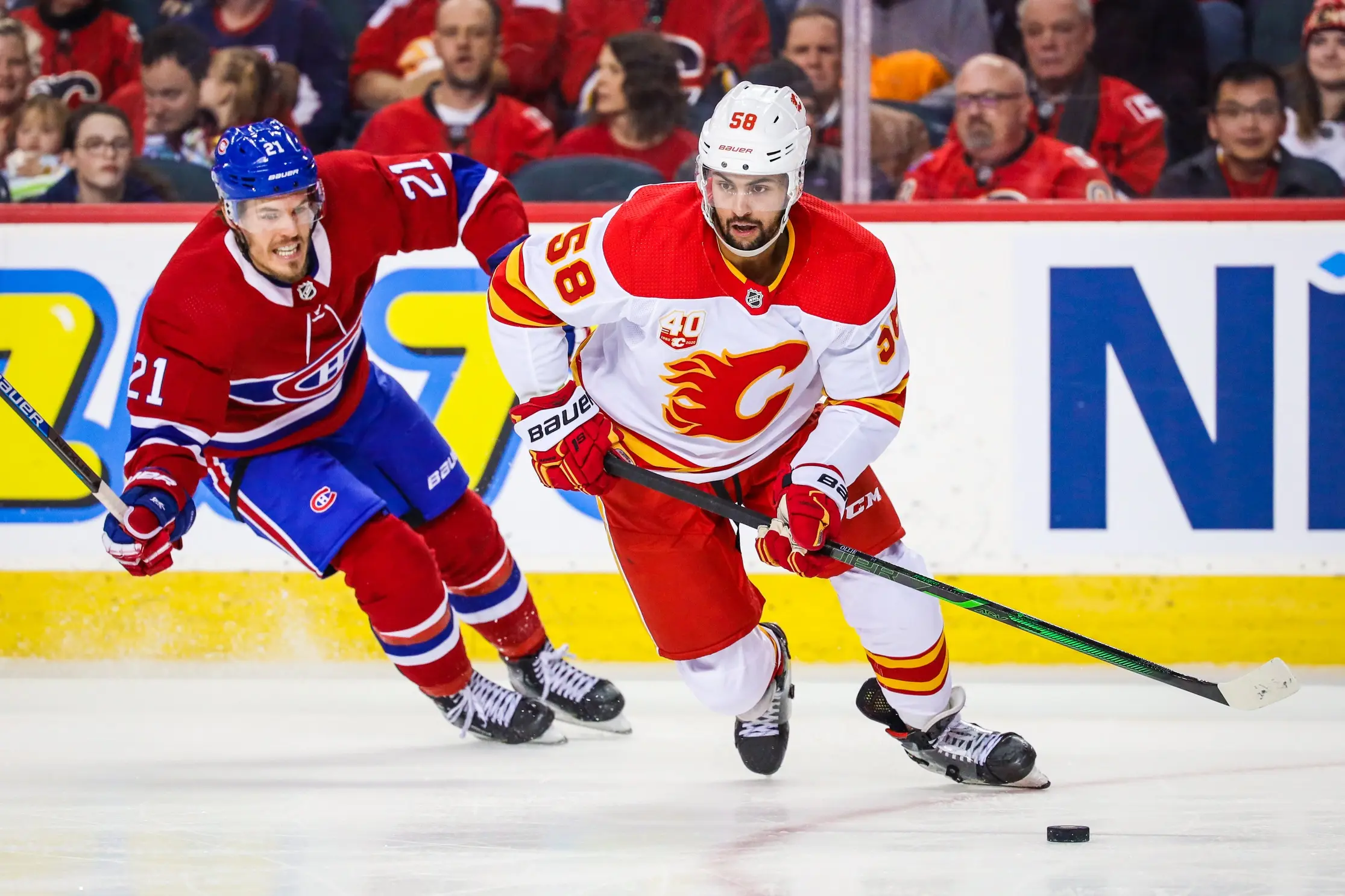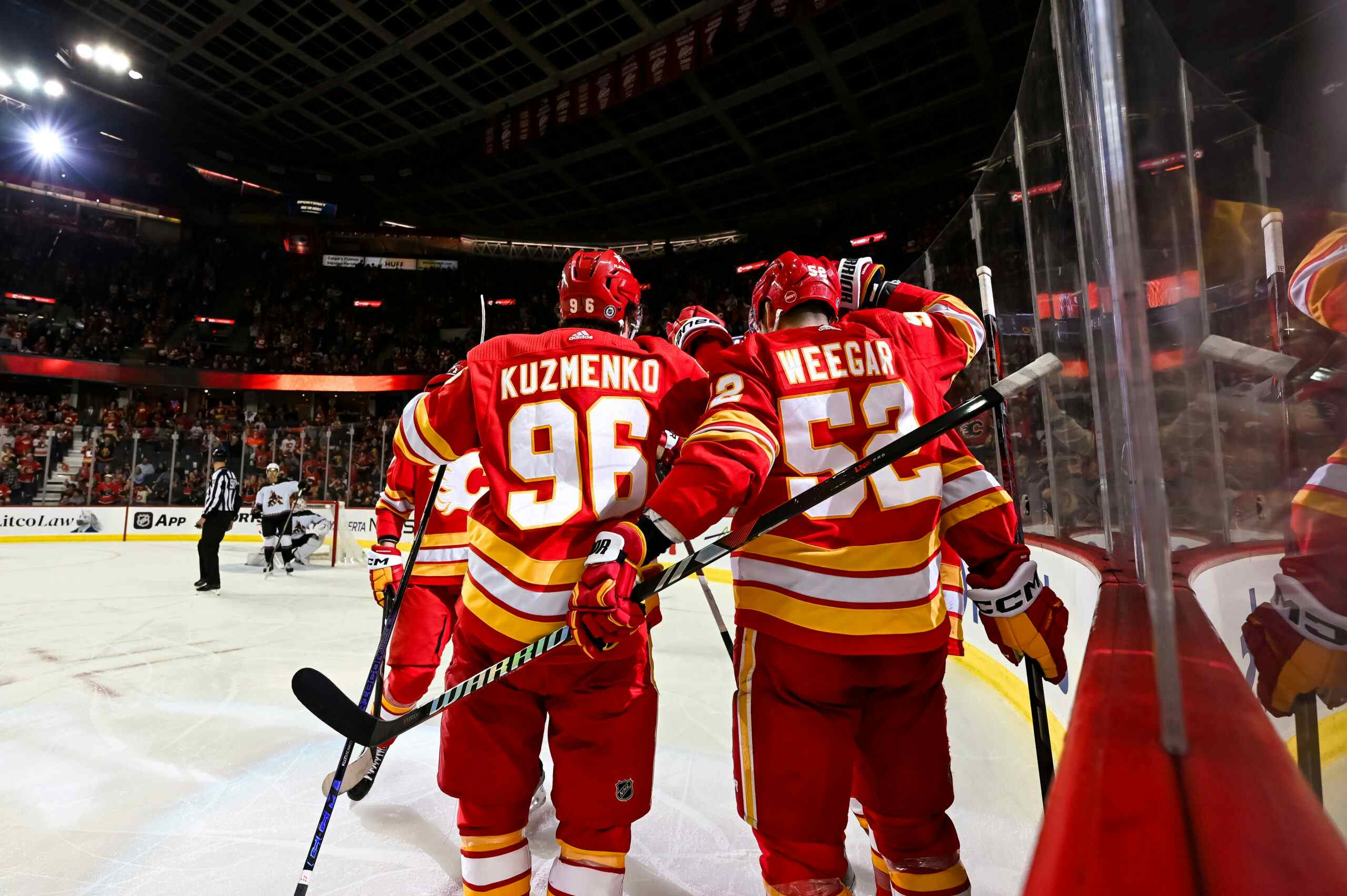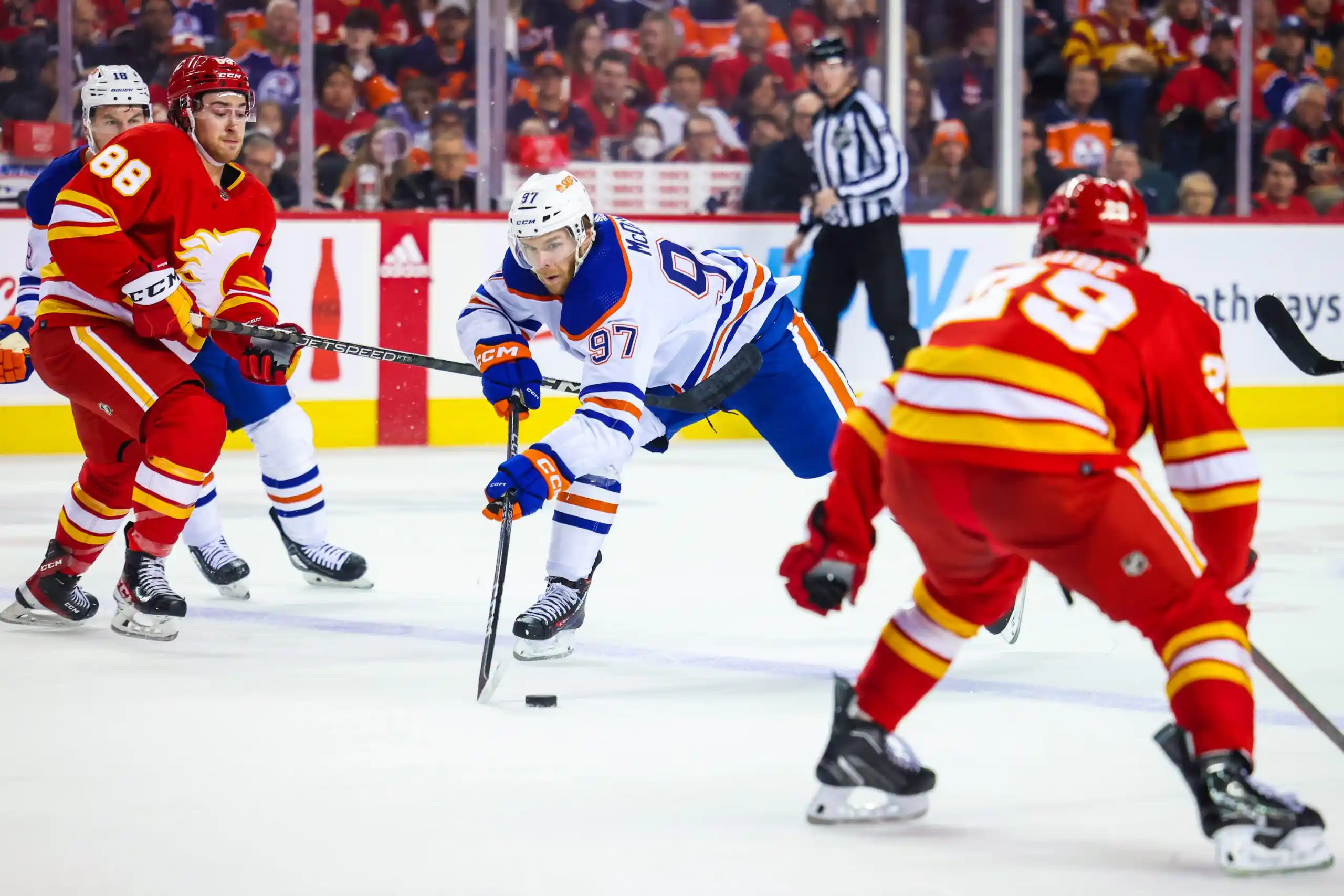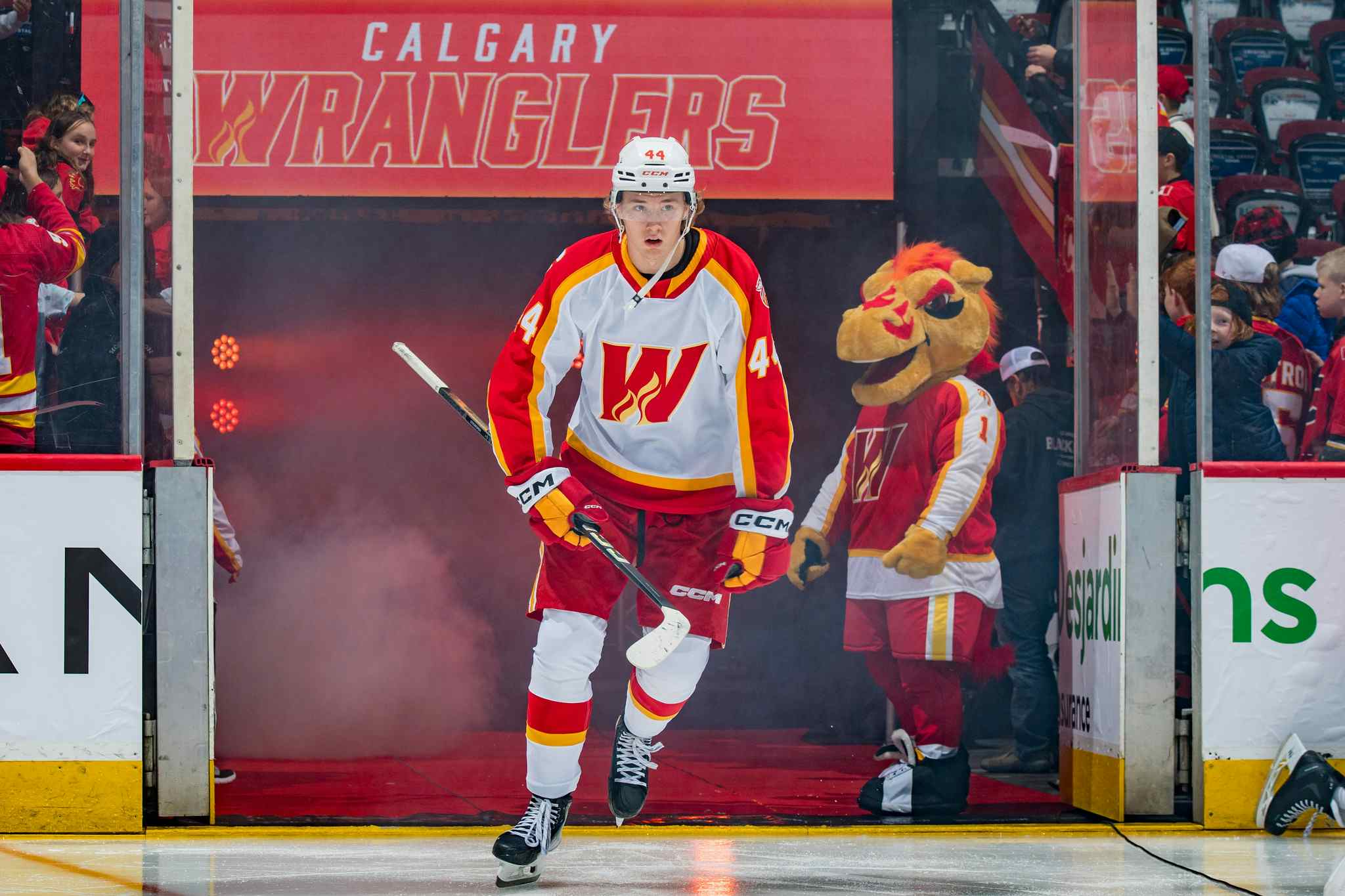Flames in seven games: 2-4-1 in sixth segment

By Ryan Pike
4 years agoThe Calgary Flames have completed 42 games of the 2019-20 regular season calendar. They’re 51.2% of the way through their season, and so we continue examining their performances in bite-sized seven game morsels. In the first segment of this season, they went 3-3-1. In their second segment, they went 3-3-1. In their third segment, they went 4-2-1. In their fourth segment, they went 2-4-1. In their fifth segment, they went 6-1-0.
In their sixth segment, they went 2-4-1.
Underlying numbers via Natural Stat Trick.
Game by game
(Percentage stats in this table are 5v5.)
| Date | Opponent | Result | CF% | SC% | HDSC% | PP | PK |
| Dec. 17 | Penguins (vs) | 4-1 L | 57.0 | 64.4 | 71.4 | 0-for-1 | 3-for-3 |
| Dec. 19 | Canadiens (vs) | 4-3 OTL | 45.0 | 44.8 | 48.0 | 1-for-1 | 2-for-2 |
| Dec. 22 | Stars (@) | 5-1 W | 49.4 | 48.6 | 50.0 | 3-for-5 | 3-for-3 |
| Dec. 23 | Wild (@) | 3-0 L | 46.0 | 46.5 | 66.7 | 0-for-1 | n/a |
| Dec. 27 | Oilers (@) | 5-1 W | 45.5 | 43.2 | 40.0 | 0-for-1 | 2-for-2 |
| Dec. 29 | Canucks (vs) | 5-2 L | 50.0 | 60.0 | 22.2 | 0-for-4 | 3-for-5 |
| Dec. 31 | Blackhawks (vs) | 4-2 L | 53.0 | 48.1 | 63.2 | 0-for-1 | 3-for-4 |
The Flames played four games at home (0-3-1) and three on the road (2-1-0). For those who like to keep track, the Flames had two wins and four losses in regulation, and went to overtime once (losing the lone trip to extra time).
The Flames out-chanced their opponents twice and generated more high danger chances three times. They scored four power play goals and allowed three.
With 45 points thus far, the Flames are performing at slightly below a playoff pace; four wins per segment translates to precisely 48 points over 42 games (and to 94 points over a full season). Because of the under-performance of basically every Pacific Division club the Flames are still in the playoff pack, but they’ll need to turn things around in order to cement themselves.
Team stats
The Flames have a 20-17-5 record through their first 42 games. They looked good against Edmonton, but a good deal of that might have been a reflection of the quality of their opponent. They still haven’t had a season-defining victory where they impose their will on the opposition for 60 minutes.
- Their goals for per game is 2.64, up from 2.63. They’re 24th overall in the NHL and 11th in the Western Conference.
- Their goals against per game is 3.02, up from 2.97. They’re 15th in the NHL, and 8th in the Western Conference.
- Their goal differential is -13, down from -9. They’re 24th in the NHL, and 11th in the Western Conference.
- Their power play is at 18.7%, up from 17.4%. They’re 18th in the NHL, and 8th in the Western Conference.
- Their penalty kill is at 83.8%, unchanged from our last check-in. It’s 4th in the NHL and 2nd in the Western Conference.
- They’ve taken 9.0 minutes of penalties per game, down from 9.3. That’s 12th-most in the NHL, and 6th-most in the Western Conference.
- Their 5v5 CF/60 is 58.39, down from 58.61. It’s the 8th highest in the NHL, and 4th among Western Conference teams.
- Their 5v5 CA/60 is 57.26, up from 56.95. It’s the 21st lowest in the NHL, and 8th lowest among Western Conference teams.
- Their 5v5 CF is 50.5%, down from 50.7%. It’s the 11th highest in the NHL, and 4th among Western Conference teams.
- Their 5v5 shooting percentage is 6.64%, down from 6.93%. It’s 29th in the NHL.
- Their 5v5 save percentage is 92.06%, up from 91.84%. It’s 13th in the NHL.
- Their PDO is 0.987, down from 0.988. It’s 26th in the NHL.
After a strong previous segment, the Flames crashed down to Earth in this segment – winning twice. They’re one of the better shot generation teams in the league, but the shooting percentage is ugly. Similarly, while their goaltending is above average it’s paired with some iffy defending. As a result, the Flames chase – a lot.
As we’ve stated previously, the two things that seem to be working consistently are their goaltending and their penalty kill. You can add their shot generation to that, a new development, but their defending has to improve to give them a fighting chance in the NHL’s weakest division.
Player stats
First, the forwards (all situations, ordered by ice time).
Game scores: 0.950 and above is considered great; 0.450-0.950 good; 0.150-0.450 fine; -0.150-0.150 bad; under -0.150 awful.
| Player | TOI | Goals | Points | P/60 | SH% | CF% | GF% | OZFO% | Game score |
| Lindholm | 822:51 | 16 | 31 | 2.26 | 16.2 | 51.8 | 46.7 | 53.8 | 0.707 |
| Gaudreau | 792:51 | 10 | 31 | 2.35 | 9.1 | 56.8 | 53.5 | 67.6 | 0.731 |
| Backlund | 760.54 | 5 | 17 | 1.34 | 6.1 | 49.2 | 50.0 | 52.4 | 0.385 |
| Monahan | 758:49 | 13 | 33 | 2.61 | 12.3 | 55.5 | 52.2 | 67.9 | 0.696 |
| Tkachuk | 745:25 | 15 | 36 | 2.90 | 13.3 | 58.3 | 55.0 | 62.4 | 0.890 |
| Ryan | 622:57 | 6 | 20 | 1.93 | 8.8 | 46.5 | 55.3 | 40.9 | 0.435 |
| Lucic | 528:57 | 3 | 9 | 1.02 | 5.9 | 54.9 | 50.0 | 50.8 | 0.243 |
| Mangiapane | 509:48 | 8 | 15 | 1.77 | 16.0 | 53.0 | 51.2 | 47.8 | 0.466 |
| Frolik | 453:16 | 5 | 10 | 1.32 | 11.4 | 48.3 | 31.4 | 46.8 | 0.247 |
| Rieder | 372:49 | 2 | 7 | 1.13 | 4.7 | 45.2 | 25.9 | 40.9 | 0.254 |
| Jankowski | 362:43 | 0 | 1 | 0.17 | 0.0 | 43.7 | 14.8 | 29.4 | 0.068 |
| Bennett | 336:52 | 4 | 6 | 1.07 | 9.1 | 54.6 | 61.1 | 53.9 | 0.312 |
| Dube | 220:42 | 3 | 7 | 1.90 | 15.0 | 45.3 | 52.9 | 45.5 | 0.306 |
| Quine | 88:15 | 1 | 1 | 0.68 | 8.3 | 51.6 | 33.3 | 49.1 | 0.179 |
| Czarnik | 81:30 | 2 | 3 | 2.21 | 22.2 | 54.6 | 75.0 | 58.9 | 0.394 |
| Rinaldo | 70:10 | 2 | 3 | 2.57 | 20.0 | 44.9 | 42.9 | 50.0 | 0.250 |
Give a hand to Elias Lindholm, who’s emerged as one of the players doing a ton of heavy lifting for the team this season. The gap in usage between him and the other forwards is pretty stark, and speaks to the trust the coaching staff has in him (and the quality of his performances).
Overall, between his offensive production and his 200-foot performance, there’s a pretty hefty game score gap between Matthew Tkachuk and the rest of the forwards. There’s Tkachuk, then Lindholm, Sean Monahan and Johnny Gaudreau, and then a big gap.
Mikael Backlund’s lack of offensive production – driven by a low shooting percentage – has seen him slide into the middle clump of the roster. Heck, Derek Ryan and Andrew Mangiapane have better game scores than he does. Eventually that will rebound given Backlund’s ice time, but for now he’s a production weak spot on the roster. (Gaudreau and Milan Lucic are both experiencing similar shooting percentage challenges.)
The bottom of the lineup continues to be a bit of a mess. The only clear thing about that group is that Mark Jankowski sticks out like a sore thumb.
The Flames’ most common line combinations at 5v5 are:
| Gaudreau | Monahan | Lindholm |
| Tkachuk | Backlund | Mangiapane |
| Lucic | Ryan | Ryan |
Now, the defence (all situations, ordered by ice time):
| Player | TOI | Goals | Points | P/60 | SH% | CF% | GF% | OZFO% | Game score |
| Giordano | 1022:10 | 4 | 19 | 1.12 | 5.3 | 50.0 | 50.0 | 49.6 | 0.633 |
| Hanifin | 900:46 | 4 | 10 | 0.67 | 5.7 | 49.6 | 40.3 | 46.8 | 0.327 |
| Andersson | 814:28 | 3 | 11 | 0.81 | 3.6 | 54.6 | 46.2 | 61.0 | 0.418 |
| Hamonic | 756:24 | 2 | 7 | 0.56 | 3.0 | 43.5 | 38.3 | 34.7 | 0.349 |
| Brodie | 703:16 | 1 | 12 | 1.02 | 4.4 | 49.0 | 50.0 | 46.0 | 0.356 |
| Kylington | 405:25 | 1 | 4 | 0.59 | 0.0 | 50.1 | 44.4 | 60.8 | 0.175 |
| Stone | 320:03 | 1 | 3 | 0.56 | 5.6 | 40.6 | 39.2 | 44.3 | 0.097 |
| Davidson | 40:37 | 0 | 0 | 0.00 | 0.0 | 56.5 | 20.0 | 55.6 | 0.367 |
36-year-old Mark Giordano has played 120 minutes more than anybody else on his team. He’s the oldest player. He’s in incredible shape, but eventually load management will need to kick in, right? Behind him – which likely explains his usage – is a very “meh” offensive blueline.
Rasmus Andersson, on his entry level contract, is the best of their so-so offensive bunch. It’s a very odd situation to keep an eye on over the next few segments. Andersson’s good, but it feels like the others are also under-performing.
And finally, goalies (all situations):
| Player | TOI | SV% | ldSV% | mdSV% | hdSV% | Game score |
| Rittich | 1880:09 | .912 | .958 | .883 | .860 | 0.788 |
| Talbot | 659:00 | .915 | .957 | .917 | .781 | 0.792 |
Nothing has really changed for the Flames in net. Rittich has struggled a bit in his last couple starts, which has eroded his overall save percentage slightly. But he’s the better goaltender in low and high-danger situations. It’s those murky middle-danger chances that he’s had issues with – in part a product of the defensive play in front of him.
Recent articles from Ryan Pike





